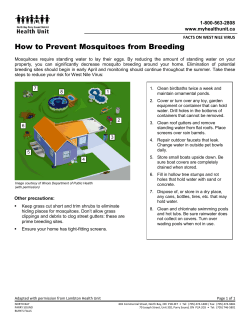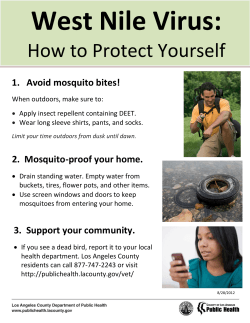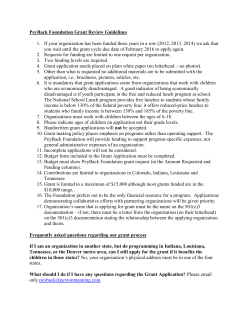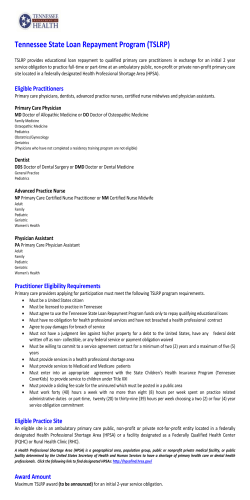
Mosquito Control Around Homes SP503-B
SP503-B Mosquito Control Around Homes Karen Vail, Associate Professor, Kristy Gottfried, former graduate student, and Reid Gerhardt, Professor, Entomology and Plant Pathology Are you supplying the perfect mosquito larval habitat in your yard? Mosquitoes can have a great impact on our lives. They can not only reduce our quality of life by ruining a relaxing evening on the patio but also harbor disease organisms and may readily pass them on to us and our pets. West Nile Virus (WNV), one mosquito-borne virus found in Tennessee, was first recorded in New York in 1999 and has since been found in most of the continental United States. Most people infected, about 80 percent of the WNV cases, will be unaware they are infected and will remain symptomless. The other 20 percent may develop flu-like symptoms such as fever, headache, muscle aches and pains, stiff neck, nausea, weakness, vomiting, and rash. Some of these cases may become severe; and the patient may experience confusion, convulsions and brain swelling. The elderly are most at risk with those over 50 years of age more likely to develop a severe case and those over 70 with compromised health at the greatest risk of death. In 2002, the first human cases of WNV were reported in Tennessee. Fifty-six Tennessee cases were reported in 2002, 26 in 2003, 14 in 2004, 18 in 2005 and five in 2006 (as of September 15). Culex species are probably the p rimary mosquitoes responsible for transmitting WNV in Tennessee. Even with this new disease, mosquitotransmitted diseases are not as common in Tennessee today as they were in the past. Although with the fairly recent introduction of the Asian tiger mosquito (Figure 1) and other non-native species into Tennessee, the potential for disease transmission is greater. There are strategies you can use to reduce the mosquito population around your home! This fact sheet will describe the different types of mosquitoes found in Tennessee as well Figure 1. Note the narrow, central, white line down the back of the thorax and striped legs. Larvae of the Asian tiger mosquito are found in containers. as strategies residents can use to prevent the buildup of the most common species found around homes, mainly those species that have larvae in containers such as tires, etc. All mosquitoes require water to reach the adult stage. The larval stages of mosquitoes require water for their development. Larvae feed on microorganisms and organic matter and grow quickly. Within seven to 12 days, more hungry mosquitoes will be waiting to ambush the next warmblooded creature they encounter. Adult mosquitoes may be found seeking refuge in your backyard in wooded areas, shrubs, dense vegetation, drainage ditches, sewers and protected areas around buildings until it is time to seek a meal. Female adults are responsible for biting — they need a blood meal to ensure that their eggs are viable. Male adults feed exclusively on plant juices and do not require blood. You may encounter three types of mosquitoes: 1.Permanent pool mosquitoes. Larvae of these mosquitoes can be found in lakes/reservoirs, ponds, swamps, marshes, sewage lagoons, etc. The water must be a permanent or semipermanent body of water (in place Open Boat Neglected Swimming Pool generally longer than three weeks). Permanent pool mosquitoes generally have a limited flight range and do not cause problems more than a mile from their aquatic habitat. 2.Floodwater mosquitoes. The eggs of these mosquitoes are deposited in damp soil at the water line. When there is heavy rainfall, the eggs are submerged and will hatch. These mosquitoes have an extended flight range and can fly several miles in search of a blood meal. 3.Container mosquitoes. These mosquitoes are commonly found in backyards. People living in homes may supply the perfect larval habitat (areas where mosquitoes live and grow) without realizing the consequences that will be evident in the near future. These mosquitoes have a limited flight range and may not venture out of the city block or your yard if enough hosts are available. You can reduce the mosquito population, especially container mosquitoes, near your home by taking a few precautionary steps. Removing or monitoring water Neglected Hot Tub Ornamental Pond Clogged Rain Gutters Flower Pot Leaky Water Faucet Bird Bath Figure 2. Potential breeding sites found around homes. Anything that will hold water for more than a few days Mosquito Identification A key to the identification of the adult female mosquitoes found in Tennessee is illustrated in Chapter 3 of UT Extension PB1685 Public Health Mosquito Control: The Tennessee Mosquito Control Handbook. This publication is available at http://eppserver.ag.utk.edu/psep/ secondlevel/thirdlevel/PHC/PHCindec.htm. c ollection sites around your home will reduce potential breeding sites. It makes sense to control mosquitoes by either removing or treating their larval habitat, thus killing them before they become annoying and before they can transmit disease organisms. Attempting to kill adult mosquitoes will work temporarily, but unless the larval sites are eliminated or treated, adults will continue to be an annoyance. Old-fashioned bug zappers, insect electrocutors and ultrasonic devices typically do not reduce mosquito populations and may attract insects from neighboring yards. Mosquito trap design is undergoing enormous evolution at this time. This is a very complicated subject that goes beyond the scope of this fact sheet. However, a thorough mosquito trap explanation can be found at the American Mosquito Control Association's Web page at http://www.mosquito.org/mosquito-information/traps.aspx. Check this Web site for updates, too. As traps become more efficient at attracting mosquitoes from an area, it will still be wise for people to protect themselves with repellents, remove larval habitat and follow a complete control plan. Remember: Mosquitoes require water for their development to the adults we all know and respect! Eliminating Larval Sites A homeowner’s goal should be to eliminate potential larval sites (Figure 2). Here are a few suggestions to get you started: • Remove containers or similar objects such as soda cans, tires, buckets, plastic sheeting and others from areas surrounding your home. • Do not allow water to remain in flower pot bases or pet dishes for longer than a week. • Clean gutters, downspouts, roofs, etc. to remove leaves and other debris that may hold standing water. • Water in bird baths and children’s wading pools should be changed at least once a week. • Tree holes or stumps often contain water. Drain them or fill them with sand or mortar. • Water the landscape so standing water cannot accumulate for more than a few days. • Inspect animal water troughs and surrounding ground for larval mosquitoes and change water if necessary. • Fill or drain depressions left by tires. • Stock a small garden pool or ornamental pond with mosquito-eating fish such as native top-feeding minnows or goldfish. • Make sure covers on pools and boats do not retain water. • Cover rain-collecting barrels with a 16-mesh screen. Because container mosquitoes will fly about a city block or so, include neighbors in your control effort. Conduct a neighborhood cleanup and remove useless containers such as cans, bottles, buckets, tires and anything else that can hold water. If neighbors do not remove potential larval spots in their yard, you may end up with their bumper crop of mosquitoes. Larvicides may be necessary to kill larval mosquitoes in ponds or other standing water that cannot be removed. Products such as those containing Bacillus thuringiensis israeliensis (Bti), available to the public as dunks or granules, can be used and have little effect on organisms other than Diptera (flies, mosquitoes, etc). Mosquito dunks resemble biscuits and can be broken into different sizes, depending on the size of the larval breeding habitat to be treated. Bti granules are also available in small quantities. Another way to reduce mosquitoes in or around homes is to reduce dense vegetation, which provides resting sites for the adults. Keeping lawns mowed can help reduce adult resting sites. Also appropriately labeled products containing permethrin, bifenthrin, cyfluthrin, malathion and others can be applied during the day to shrubbery and other resting sites listed on the label. Ways to Avoid Mosquito Bites • Repellents, such as DEET or Permanone (containing permethrin), can be applied to your clothing to protect you when outdoors. DEET can also be applied to skin but may cause allergic reactions. Avoid eyes, nose, lips, cuts and scratches, and other sensitive areas when applying repellents. Always apply the repellent according to the label. If repellents are to be used on young children, use products containing 30 percent DEET and only on children older than 2 months. If an allergic reaction from a repellent is suspected, wash the area with soap and water and seek medical attention. EPA-registered repellents containing picardin or oil of lemon eucalyptus are two newer repellent recommendations from the CDC (Centers for Disease Control and Prevention). Check the CDC’s Web site for updates on repellent use (http:// www.cdc.gov/ncidod/dvbid/westnile/qa/insect_repellent. htm). • Wear light-colored, long-sleeved shirts and long pants when venturing outdoors. • Avoid areas where adult mosquito populations are high. • Avoid shaded locations and locations with overgrown vegetation where mosquitoes may be resting or waiting for a meal. • Repair window and door screens if they are torn. The Tennessee Department of Health does not typically recommend spraying insecticides to kill adult mosquitoes as the only means of mosquito control. Counties, municipalities and other entities do not usually have the necessary budget and trained personnel to conduct an effective abatement program. This subject is discussed in detail in a paper presented by K. Gottfried, previously of the Tennessee Department of Health (http://eppserver.ag.utk.edu/personnel/Vail/TNDOH_Co_Dirs_Mtng.pdf). For these reasons, an emphasis is placed on personal protection and reducing larval habitat. If, after reading the Gottfried paper, you are still interested in starting an abatement program, you should contact the Tennessee Department of Health. Suggested sources for information on starting an abatement program can be found in the Vail, Gerhardt and Jones article listed below. For specific pesticide suggestions, see the UT Extension PB1690 Insect and Plant Disease Control Manual at http://eppserver.ag.utk.edu/redbook/sections/structural.htm. Sources Anonymous. 2006. Traps. American Mosquito Control Association Web site at http://mosquito.org/mosquito-information/traps.aspx. Anonymous. 1997. Mosquito Handbook: A Guide to Identification & Management. Tennessee Valley Authority, 2nd Edition. CDC West Nile Virus Web site at http:www.cdc.gov/ ncidod/dvbid/westnile/index.htm. Vail, K.M. 2006. First West Nile Virus Human Death of 2006 Occurs in Rutherford County. UT E&PP “What’s Happening” newsletter, September 8, 2006. http:// eppserver.ag.utk.edu/Whats/wh2006/Issue-12-2006.htm Vail, K., R. Gerhardt and C. Jones, 2004. Do Mosquito Abatement Districts Based on Adulticiding as the Only Control Source Provide Effective Control? “What’s Happening” Newsletter. University of Tennessee Agricultural Extension Service Entomology & Plant Pathology. EPP#60 Volume No. 10, July 23, 2004. http://eppserver.ag.utk. edu/Whats/whatshap.htm. Precautionary Statement To protect people and the environment, pesticides should be used safely. This is everyone’s responsibility, especially the user. Read and follow label directions carefully before you buy, mix, apply, store, or dispose of a pesticide. According to laws regulating pesticides, they must be used only as directed by the label. Disclaimer This publication contains pesticide recommendations that are subject to change at any time. The recommendations in this publication are provided only as a guide. It is always the pesticide applicator’s responsibility, by law, to read and follow all current label directions for the specific pesticide being used. The label always takes precedence over the recommendations found in this publication. Use of trade or brand names in this publication is for clarity and information; it does not imply approval of the product to the exclusion of others that may be of similar, suitable composition, nor does it guarantee or warrant the standard of the product. The author(s), the University of Tennessee Institute of Agriculture and University of Tennessee Extension assume no liability resulting from the use of these recommendations. Visit the UT Extension Web site at http://www.utextension.utk.edu/ SP503-B 10/06(Rev) 07-0063 Programs in agriculture and natural resources, 4-H youth development, family and consumer sciences, and resource development. University of Tennessee Institute of Agriculture, U.S. Department of Agriculture and county governments cooperating. UT Extension provides equal opportunities in programs and employment.
© Copyright 2026



















